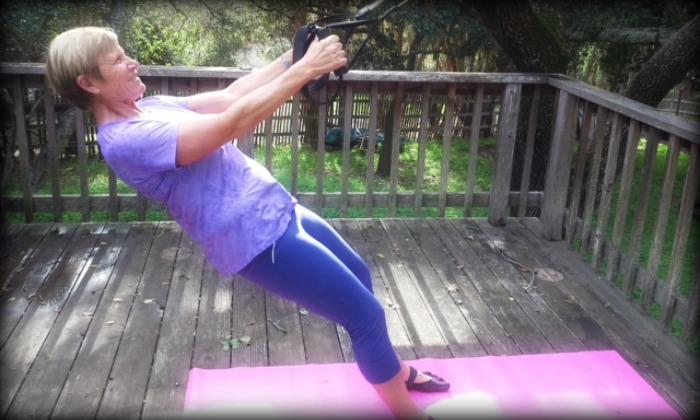One of the most important philosophies for the Ripped Grandma Wellness Movement is to bring you, the members, relevant information that is useful for your daily life. My data comes from various professional journals I subscribe too and other research-oriented sites. I try to back up everything I bring you with research.
That being said I feel there is a great need for education on strengthening the back. The spine is frequently a site of Osteopenia or Osteoporosis. It also is the area where we feel achy either in the neck, mid or low back, often times because of poor postural habits. If you have been diagnosed with Osteoporosis or Osteopenia or if you want to prevent it from happening today’s “Row” options are made for you!
The most challenging part about working with osteoporosis or osteopenia is maximizing the strength benefits while minimizing risk!
Exercise characteristics that had the biggest influence on increasing BMD, according to a 2009 study from the University of Michigan where studies were analyzed from 1961 to present 2009, is the magnitude of muscle strain an exercise exerts because of force placed on muscle and bone. Weight training is an example of this.
Some Facts About Your Muscles…
- The rate of muscle strain an exercise exerts. This indicates the speed by which repetitive, high-impact exercises, such as tennis or plyometrics, are performed.
- The frequency by which muscle strains occurs. Running is a prime example of this as the
impact on muscles is not only repetitive but continues for a long period of time.
In another 2015 research paper (Tagliaferri et al.2015) mechanical loading was the most important determinant of bone strength which influences muscle size and force which correlates with BMD (Bone Mineral Density).
The force of muscle pulling against bone appears to be enough to stimulate bone growth even if the actual stress placed on the bone is moderate. While running and jumping are not always appropriate for individuals today’s exercise is one that almost everyone can benefit from.
As usual please check with your doctor or if your case is severe, and remember all movements should be pain-free.
The “row” is a common pull movement, not to be confused with cardio rowing. It addresses the posture muscle that keeps your shoulders down and in. It can benefit the core, especially while standing in a split stance and strengthens back muscles so that you can build bone in your spine. In addition, many people carry tension across their upper back, this move counter
acts a lot of our forward bent over daily movement, ie computer, cooking, driving, living etc…
The recommendation is 2 sets of 8-10 reps. I have included 3 variations. Before starting a wall stretch for pecs might feel good along with some of our other mid-back mobility moves I have shared in previous posts. (Click Here to Check Out My Facebook Group for These Posts)
Special Notes…
- If you are just starting out or have not been involved with activity start with one set.
- If you have been actively doing rows make sure that the last few reps are challenging whatever your choice of
row is! Not to pain but to fatigue.
Let’s Row…
- Row with a light band standing in a split stance, using the band in both hands pull straight back, keeping shoulders gently pulled down and in. Band color may vary, generally darker colors( blue, violet, gray) are harder and provide more tension. You can also tell by the thickness of the band.
- Single or double Hinged row – A throwback to Thanksgiving using a common 8lb bag of potatoes or onions. Hinge from the hip and bring bag or weight up alongside hip, elbow reaches to the ceiling.
- TRX Row – facing attachment holding straps directly under shoulders, extend into plank position and pull up to beginning position. You may use split stance to start with (less challenging).
- Increase the difficulty by using a single leg. (most challenging)
Please let me hear your feedback on these moves in a comment below! Until Next Time! ~ RG
Want to Connect with other Ripped Grandma’s?
Join Me In My Facebook Group…




